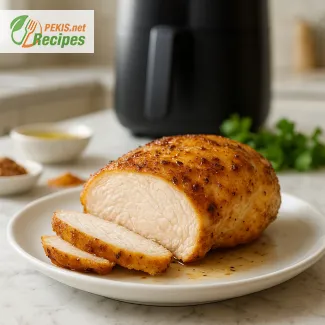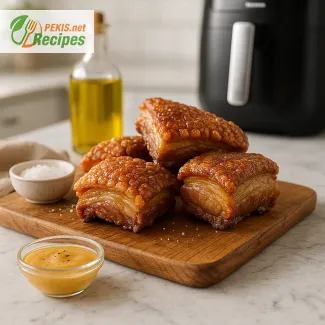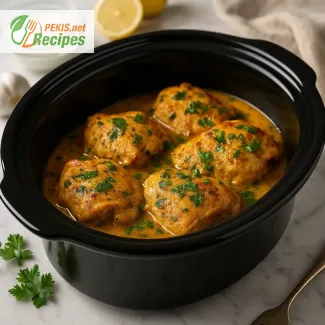
Air fryer chicken perfection: tender whole breasts with smoky paprika
A modern favorite for fast, flavorful and healthy home cooking
If you're looking for a quick, flavorful and healthy way to cook whole chicken breasts, this air fryer method with paprika might become your new weeknight staple. The technique delivers everything modern home cooks crave: crispy golden exterior, juicy and tender interior, and minimal prep and clean-up. In just 20 minutes, you’ll have a dish that balances texture, taste, and nutrition, while elevating even the simplest chicken cut into something crave-worthy.
Thanks to the rising popularity of air fryers and the continued focus on light, wholesome meals, recipes like this one have become household favorites around the globe. Using whole chicken breasts not only gives you a richer bite and better moisture retention, but it also helps you avoid the dryness that often plagues thinly sliced chicken. Add a simple paprika seasoning blend, and you unlock deep, smoky, subtly spicy notes that make this dish stand out without overwhelming the natural flavor of the meat.
Why whole chicken breasts in the air fryer work so well
The air fryer has revolutionized the way people cook chicken. It circulates hot air around the meat, creating a crisp outer layer without the need for deep frying or excess oil. For whole chicken breasts, this cooking method is especially beneficial. Their thicker structure holds moisture better than fillets, which can dry out quickly if overcooked.
Another advantage is that cooking them whole makes meal planning easier. A single large chicken breast, when prepared correctly, can be sliced and served over salads, paired with grains like quinoa or rice, or stuffed into wraps and sandwiches. This makes it a versatile component in any healthy eating routine.
The magic of paprika: more than just color
Paprika isn't just about its striking red hue—it adds depth, smokiness, and mild heat depending on the variety. In this recipe, using either sweet or smoked paprika enhances the chicken with a flavor profile that's rich and earthy, yet delicate enough for all palates. It caramelizes beautifully in the air fryer, contributing to the appealing golden crust.
To create the best result, it's important to use fresh, high-quality paprika and combine it with salt, garlic powder, and optionally a touch of olive oil or another neutral oil. This mix forms a light coating that helps lock in moisture and flavor during the high-speed cooking process of the air fryer.
Key tips for juicy, tender results
Cooking a whole chicken breast evenly and perfectly in the air fryer comes down to a few practical steps. First, allow the meat to rest at room temperature for 10–15 minutes before cooking. This helps ensure even heat distribution and prevents the outer layer from becoming too dry while the center finishes cooking.
Secondly, do not overcrowd the air fryer basket. Good air circulation is critical for that crisp finish. If you’re making multiple breasts, cook them in batches or use a rack if your appliance supports it. Finally, let the chicken rest for at least 5 minutes after cooking before slicing—this step allows juices to redistribute, making each bite more flavorful and moist.
Meal pairing and serving suggestions
This recipe is highly adaptable when it comes to sides. For a low-carb, high-fiber option, serve it alongside roasted cauliflower, grilled zucchini, or a kale salad. Want something more comforting? Try it with mashed sweet potatoes or couscous.
The mildly smoky paprika flavor pairs well with lemon-based sauces, herbed yogurt dips, or even a drizzle of tahini-lime dressing. If you’re prepping for meal plans, cooked whole breasts can be stored and used throughout the week in grain bowls, sandwiches, or quick stir-fries.
Air fryer benefits beyond convenience
Incorporating an air fryer into your routine can promote healthier eating without sacrificing flavor or texture. It reduces the need for excess oil, making it ideal for cooking lean proteins like chicken. It also shortens cooking times dramatically—what normally takes 30–40 minutes in the oven can be done in 15–20 minutes in the air fryer. That means more time saved and less energy consumed.
For those following specific dietary preferences—such as gluten-free, dairy-free, or low-fat lifestyles—this recipe is naturally aligned. You can adjust the seasoning to your needs without altering the technique, making it a base method that can serve multiple tastes and goals.
Flavor-enhancing variations to explore
While the classic paprika coating is a winner on its own, the recipe can easily be customized. Add cumin and chili powder for a Tex-Mex twist, or swap in Italian herbs for a Mediterranean version. A touch of lemon zest or dijon mustard in the marinade brings a refreshing brightness, ideal for warmer seasons.
You can also marinate the whole chicken breasts in advance—overnight in the fridge with olive oil, garlic, paprika, and a splash of vinegar—to infuse even deeper flavor. This method also tenderizes the meat, making the final product even more succulent.
What to look for when choosing chicken
Not all chicken breasts are created equal. For best results, use fresh, boneless, skinless whole chicken breasts that are uniform in thickness. Organic or free-range poultry generally has better flavor and texture, though any high-quality fresh chicken will work well. If using frozen meat, make sure it is fully thawed before seasoning and air frying.
Avoid thin or overly trimmed pieces—they may cook too quickly and lack the meaty texture that defines this recipe. When choosing multiple breasts, pick similar sizes to ensure consistent cooking times and results.
Common mistakes to avoid
There are a few pitfalls you can sidestep to make this dish flawless every time. First, avoid overcooking. Use a meat thermometer to ensure the internal temperature reaches 74°C (165°F), the safe zone for poultry. Second, don’t skip the resting period post-cooking—this small step significantly enhances juiciness.
Lastly, steer clear of seasoning too early if not cooking immediately. Salt draws out moisture over time, which can leave the surface dry. If you're prepping ahead, apply dry rubs closer to the cooking time, or use a wet marinade instead.
Making it a staple in your rotation
Once you’ve mastered this air fryer method, it’s easy to integrate it into your regular meal routine. It’s an ideal choice for busy families, fitness enthusiasts, and anyone wanting a reliable, healthy protein source that doesn’t compromise on flavor or texture. Whether served fresh or used as a meal prep base, whole chicken breasts cooked in the air fryer with paprika deliver satisfying results every time.
- Prepare the chicken: Pat dry the chicken breasts with paper towels. Let them sit at room temperature for 10–15 minutes before cooking for even heat distribution.
- Make the seasoning mix: In a small bowl, combine sweet paprika, garlic powder, onion powder, salt, black pepper, and smoked paprika (if using).
- Coat the chicken: Rub each chicken breast evenly with olive oil and lemon juice. Sprinkle the spice mix generously over the entire surface, making sure both sides are coated.
- Preheat the air fryer: Set the air fryer to 200°C (392°F) and preheat for 3 minutes.
- Cook the chicken: Place the chicken breasts in the air fryer basket in a single layer. Do not overcrowd—cook in batches if necessary.
- Air-fry: Cook at 200°C (392°F) for 10 minutes. Flip the chicken and cook for another 8–10 minutes, or until the internal temperature reaches 74°C (165°F).
- Rest the chicken: Remove the chicken breasts and let them rest for 5 minutes before slicing. This step allows the juices to redistribute for maximum tenderness.
Elevate your air-fried chicken: creative ways to enhance the classic paprika breast
Transforming a simple recipe into a standout favorite with smart upgrades
The simplicity of a paprika-seasoned whole chicken breast cooked in an air fryer is part of its appeal—but that doesn’t mean it can’t be elevated further. With a few thoughtful additions or substitutions, this already satisfying dish can become richer in flavor, more nutritious, and even better suited to your individual taste preferences. Whether you’re preparing it for a family dinner, meal prepping for the week, or cooking for guests, small adjustments can yield big results.
Use brining for more flavor and moisture
One of the most effective techniques to upgrade this dish is to brine the chicken breasts before cooking. A simple brine of water, salt, and sugar for 30–60 minutes can dramatically improve the final texture. Brining helps the meat retain moisture and enhances seasoning absorption, resulting in a more succulent, flavorful interior.
For an aromatic twist, try adding herbs like rosemary, bay leaf, or peppercorns to the brine. If you prefer a more intense flavor, a buttermilk marinade with paprika, garlic, and a touch of mustard will tenderize the meat and add complexity.
Upgrade your spice blend for deeper flavor
Paprika provides a warm, smoky foundation, but it can be the starting point for a more layered taste. Adding cumin brings a nutty depth, chili powder adds gentle heat, and turmeric introduces a slightly earthy note with anti-inflammatory benefits.
For a Mediterranean flair, combine dried oregano, thyme, and lemon zest with the paprika. For a Middle Eastern version, incorporate sumac and coriander. These modifications change the flavor profile while keeping the preparation simple and approachable.
Consider different fats for coating
Using olive oil gives a clean, fruity base that allows the spices to shine, but experimenting with other oils can subtly shift the final result. Avocado oil has a higher smoke point and a neutral flavor that suits air frying particularly well. For a buttery richness, a small amount of melted ghee can be used sparingly—especially good when paired with smoky paprika and garlic.
If you're aiming for a lighter version, you can reduce the amount of oil and use a light spritz of cooking spray instead. Just be sure to lightly coat both sides so the seasoning adheres and forms a crust in the air fryer.
Make it a complete dish with vegetable pairings
This chicken recipe is naturally lean and high in protein, which makes it a great anchor for many balanced meals. To add more nutrition and flavor, roast vegetables alongside the chicken in a double-layer air fryer or cook them separately and serve as a side.
Bell peppers, red onions, zucchini, and cherry tomatoes complement the paprika seasoning well. For a starch component, try air-fried sweet potatoes, cauliflower mash, or a scoop of bulgur wheat or quinoa salad with fresh herbs.
Why homemade always tastes better
Store-bought pre-cooked chicken may save time, but it rarely matches the flavor and texture of homemade air-fried chicken. When you make this dish yourself, you control the ingredients, avoiding excess sodium, preservatives, or low-quality oils. Fresh chicken also tends to be juicier and more tender than pre-packaged alternatives, especially when properly seasoned and rested after cooking.
Homemade preparation allows you to personalize each element of the recipe—from the spice level to the amount of fat—and ensures that you’re serving a dish that’s both nourishing and tailored to your needs.
Common mistakes and how to avoid them
Even with a simple recipe like this, there are a few pitfalls to watch for. The most frequent mistake is overcooking the chicken, which leads to a dry, tough texture. Use a meat thermometer to check for doneness; the internal temperature should reach 74°C (165°F) and no higher.
Another issue is uneven cooking, especially if the chicken breasts vary in size or thickness. For consistent results, either pound them to an even thickness or separate larger pieces into smaller portions. Also, avoid placing too many breasts in the air fryer basket at once—overcrowding limits air circulation and results in a soggy finish.
Skipping the resting time after cooking is another common misstep. Allowing the chicken to rest for 5 minutes before slicing helps the juices redistribute, making each bite moist and full-flavored.
Healthier substitutions without sacrificing taste
This dish is already quite health-conscious, but there are ways to tailor it further. Replace standard salt with a potassium-based salt substitute to lower sodium intake. Use low-sodium spices and unsweetened lemon juice rather than marinades that contain hidden sugars or additives.
You can also create a plant-based version by swapping chicken breasts for extra-firm tofu or thick slices of portobello mushrooms, seasoned and air-fried using the same spice blend. These options maintain the dish’s flavor integrity while expanding its accessibility to vegetarian or vegan diets.
Add a sauce or dip to elevate the experience
Though the chicken is flavorful on its own, adding a complementary dip can take the dish to the next level. A simple garlic-yogurt sauce, made from Greek yogurt, lemon juice, minced garlic, and herbs, pairs beautifully with paprika chicken.
For more heat, try a harissa mayo or a spicy tomato relish. If you're keeping things light, a lemon herb vinaigrette drizzled over sliced chicken adds freshness and balance.
The core technique of air-frying whole chicken breasts with paprika is reliable, fast, and satisfying—but it’s also a canvas for creativity. By experimenting with different spices, marinades, oils, and side dishes, you can continually reinvent this recipe to suit the season, the occasion, or your personal taste.
Whether you're keeping it classic or turning it into something new each time, this dish offers a flavorful, healthy, and highly adaptable base for countless delicious meals.
Allergens present in the recipe:
- None (This recipe is naturally gluten-free, dairy-free, nut-free)
Suggestions for allergen substitution:
- If sensitive to paprika or nightshades, substitute with a mix of turmeric and cumin.
- For oil-free diets, air-fry without oil but reduce the temperature slightly and monitor closely.
Vitamins and minerals per serving (approximate):
- Vitamin B6: 0.9 mg – supports brain development and immune function
- Vitamin B12: 0.3 µg – important for nerve tissue health and red blood cell formation
- Vitamin D: 0.5 µg – helps regulate calcium and phosphate in the body
- Iron: 1 mg – supports oxygen transport in the blood
- Potassium: 420 mg – aids in fluid balance and muscle contractions
- Magnesium: 35 mg – important for energy production and nervous system regulation
- Phosphorus: 240 mg – crucial for bone health and cellular repair
- Zinc: 1.2 mg – essential for immune function and wound healing
Antioxidants per serving (approximate):
- Beta-carotene: 120 µg – contributes to healthy vision and skin
- Lutein + Zeaxanthin: 80 µg – supports eye health and may reduce risk of chronic eye diseases
- Capsanthin (from paprika): 1.8 mg – has anti-inflammatory and antioxidant properties
- Vitamin E: 1.2 mg – protects cells from oxidative stress and boosts skin health





